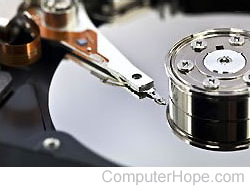Backing storage

The term backing storage refers to any non-volatile data storage that retains computer's data, even after the computer is powered off. Common types of backing storage devices are hard drives, SSD (Solid-State Drive), external hard disk drives, optical media such as CD (Compact Disc) or DVD (Digital Versatile Disc), and flash media such as thumb drives and memory sticks. Older computer systems also used floppy disks and magnetic tapes as backing storage. On modern systems, especially computers like netbooks, cloud storage services may also be used as backing storage.
The term backing store refers to any memory where data is stored but not executed. This term may describe a disk or the next device down in the memory hierarchy, like from RAM to cache.
Why is backing storage needed?
Without some type of backing storage, the computer cannot access its data after it's turned off. For example, volatile memory like RAM (Random-Access Memory) loses all information if the computer is turned off or rebooted. To prevent information you have been working on from being lost, it is saved to a backing storage device like a hard drive.
Archive, Backup, CD terms, Cloud storage, Data warehouse, Disk drive, External drive, Fixed storage, Floppy drive terms, Hard drive, Magnetic tape, Memory stick, Non-volatile, Optical disc, Secondary storage, Solid-state drive, Storage device, Tape drive, USB flash drive
